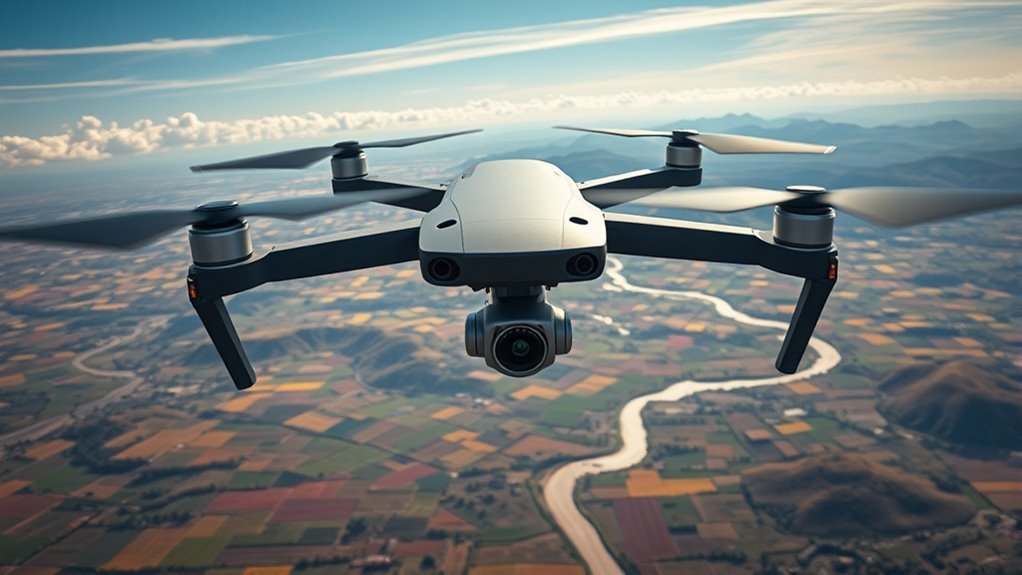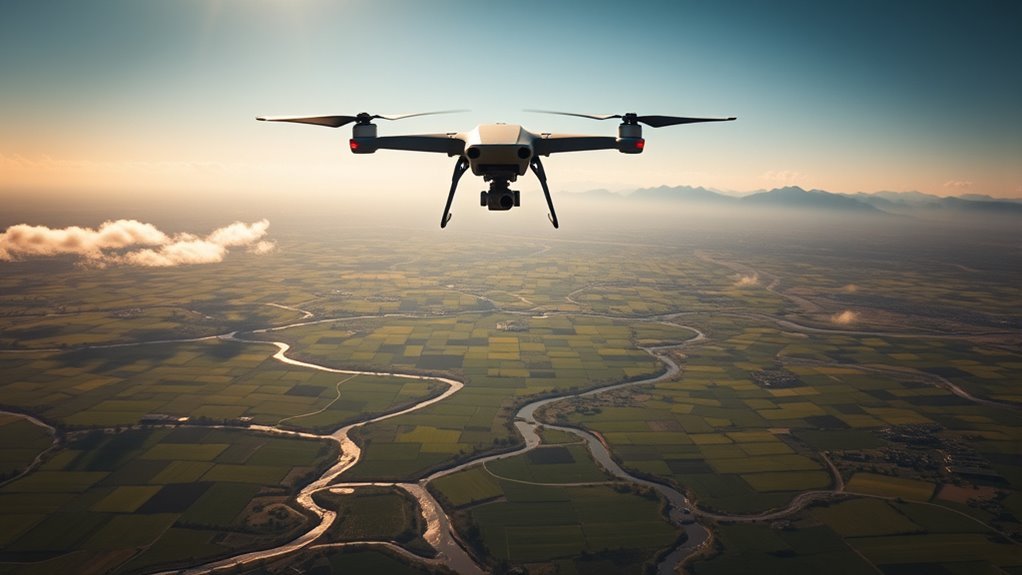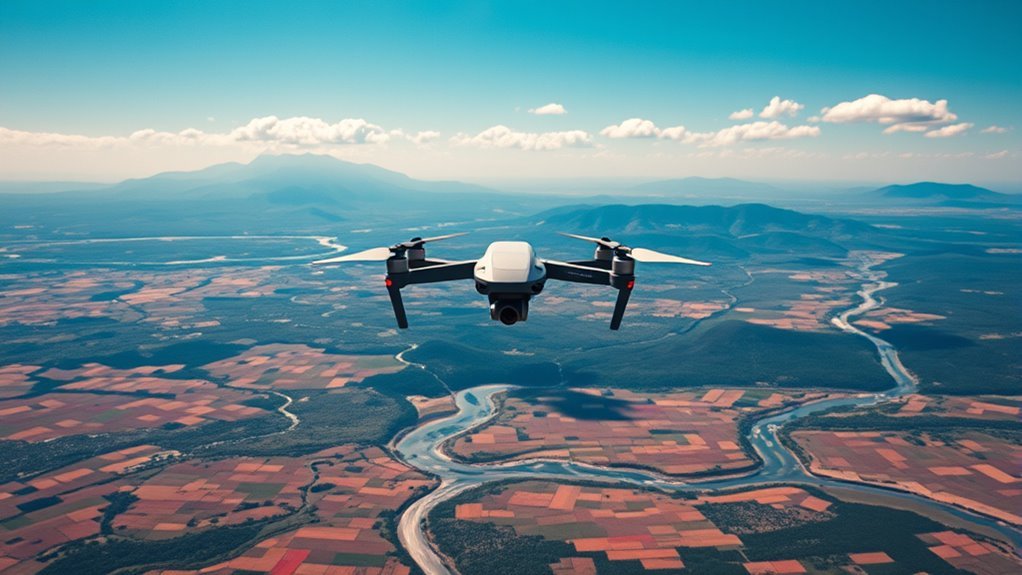Drones can travel varying distances based on several key factors. You’ll need to take into account battery life, weight, and payload capacity, all of which directly impact travel range. Environmental conditions, like wind and altitude, further influence performance. Additionally, regulatory limitations may restrict how far you can fly. A high-end consumer drone might achieve up to 7 miles under ideal conditions. Continue to explore these factors to understand the real-world capabilities of your drone further.
Factors Affecting Drone Range

When considering how far a drone can travel, several factors come into play that greatly influence its range. First, the drone technology itself determines the maximum distance it can cover, as different models have varying capabilities. You’ll want to pay attention to the frequency bands used for communication; lower frequencies often provide longer ranges but can be prone to signal interference. Environmental elements such as terrain, obstacles, and weather conditions can also impact your drone’s performance. For instance, dense urban areas may introduce more signal interference, reducing your operational range. Additionally, battery capacity is a critical factor that significantly affects flight time and range. Understanding these factors is essential for maximizing your drone’s potential and ensuring you can navigate freely without unexpected limitations. Moreover, line of sight requirements are crucial to maintain safe operation and compliance with regulations.
Battery Life and Its Impact

Battery life plays a pivotal role in determining how far a drone can effectively travel. It directly influences flight duration and, consequently, the distance covered. High battery efficiency allows for longer flights, enabling you to explore more extensive areas without the worry of recharging. Each drone’s battery has a finite number of charging cycles before its performance starts to degrade, which impacts overall range. If you’re aiming for maximum freedom in your aerial adventures, understanding how to optimize battery life is essential. You’ll want to take into account factors like flight style and environmental conditions, as these can greatly affect battery performance. Furthermore, the DJI Mavic 3 Enterprise’s superior battery technology enhances its endurance compared to other drones. Ultimately, balancing battery efficiency and charging cycles will empower you to maximize your drone’s travel potential. Additionally, environmental conditions such as wind and temperature can significantly impact battery efficiency and, therefore, travel distance.
Weight and Payload Considerations

While optimizing a drone’s travel distance, weight and payload considerations are essential factors to assess. The drone’s payload capacity directly affects how far it can travel, as increased weight can reduce flight time and distance. Proper weight distribution is critical to maintain stability and control. Here are three key points to keep in mind:
- Payload Capacity: Know your drone’s maximum payload to avoid overloading, which can limit performance. Additionally, a drone’s battery life is crucial since longer flight durations are essential for covering greater distances.
- Weight Distribution: Guarantee even weight distribution to enhance stability during flight and prevent unwanted maneuvering. This balance can also improve the drone’s energy efficiency by reducing power consumption.
- Materials: Choose lightweight materials for accessories to maximize your drone’s efficiency without sacrificing functionality.
Environmental Conditions
Although you might focus on the drone’s specifications, environmental conditions play an important role in determining how far a drone can travel. Weather conditions, such as wind speed and precipitation, can greatly impact flight stability and battery life. High winds can force your drone to expend more energy, reducing its range. Additionally, altitude effects come into play; as altitude increases, the air becomes thinner, which can lead to decreased lift and efficiency. This means that a drone may not perform ideally at higher elevations, further limiting its travel distance. Understanding these factors is vital for maximizing your drone’s capabilities and ensuring you can explore your desired areas without unnecessary limitations.
Regulatory Limitations on Flight Distance
Understanding the regulatory limitations imposed on drone flight distance is essential for any operator aiming to maximize their aerial capabilities. Legal restrictions and airspace regulations can greatly impact how far you can fly. Here are three vital points to keep in mind:Understanding drone flight regulations is crucial for operators to optimize their aerial operations and ensure compliance.
- Visual Line of Sight: Many jurisdictions require you to maintain a visual line of sight (VLOS) with your drone, limiting its distance from you.
- Restricted Airspace: Certain areas, such as near airports and military zones, are off-limits, affecting your flight planning.
- Altitude Restrictions: Regulations often impose maximum altitude limits, which can indirectly restrict horizontal flight distance.
Frequently Asked Questions
Can Drones Fly in Rain or Snow?
Drones can fly in rain or snow, but drone performance factors like moisture exposure and temperature can greatly impact functionality. Conducting a weather impact analysis is essential to guarantee safe and effective operation in adverse conditions.
How Do Drone Models Differ in Travel Distance?
Drone models vary considerably in travel distance based on their specifications and battery efficiency. Higher-capacity batteries and advanced aerodynamics typically enhance range, allowing you greater freedom to explore diverse environments and complete complex tasks efficiently.
What Are Common Drone Maintenance Tips for Optimal Range?
To guarantee your drone’s range feels limitless, prioritize battery care and conduct propeller inspections. Neglecting these essentials can ground your soaring ambitions, so keep everything in top condition for maximum aerial freedom and performance.
Are There Drones Designed for Long-Distance Travel?
Yes, there are long range drones specifically engineered for extended travel. They undergo rigorous endurance testing to guarantee peak performance. By choosing the right model, you can explore vast distances with enhanced reliability and efficiency.
How Does Drone Altitude Affect Its Travel Distance?
You’d think higher altitude guarantees greater travel efficiency, but it can actually hinder a drone’s performance. Increased altitude impacts air density, leading to reduced lift and efficiency, ultimately limiting how far your drone can go.

